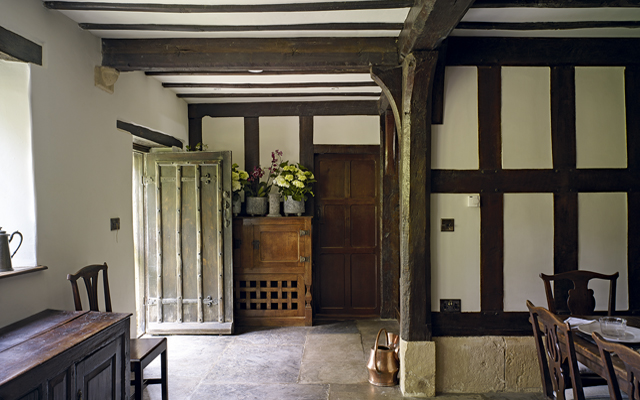A Cotswold masterpiece
Tower Close, Snowshill, Gloucestershire. The home of Jamie and Claire Wright. Alan Calder celebrates an important Cotswolds Arts & Crafts house


In 1916, in the village of Snowshill in the north Cotswolds, an astute London entrepreneur with a passion for building and a gifted Birmingham architect came together to create an important Arts-and-Crafts house. The entrepreneur, Sydney Bolton Russell (1866–1938), had an innate talent for spotting the potential of disregarded Cotswold buildings.
In the early 1900s, he was a manager for the Midlands brewer Samuel Allsopp and Sons and travelled the country inspecting its public houses. On one of his trips, he came upon the Lygon Arms in Broadway. Although the village was liberally endowed with inns, many of them interesting historic buildings, he shrewdly recognised that the Lygon Arms stood apart due to its impressive size and imposing 16th-century frontage with four towering gables. This, he realised, had the potential to be more than just an inn relying on bar trade from locals.
Ambitious and confident of his abilities and business acumen, Russell obtained financial backing, bought the building from the Allsopps and, in 1903, found himself owner of the property. Adopting the Cotswold country house of the Tudor and Stuart period as his model, he transformed the inn into a hotel of international repute. He recounted his happy and eventful experiences in his book The Story of an Old English Hostelry (1914), but, by 1915, he felt the need to move out of the hotel and seek a comfortable house nearby to sepa-rate his business and family life.
In the village of Snowshill, two miles to the south of Broadway, he found a derelict yeoman farmer’s house of about 1600 that had been split into three cottages and then abandoned. They stood on a sloping site at the eastern edge of the village commanding fine views over the Cotswolds and the Vale of Evesham. The surrounding pasture had long been known as Tower Close and this was, presumably, the inspiration for the striking new tower that was to form the centrepiece of his future home.
Russell purchased the ruin from the Snowshill Manor estate when it was offered for sale by auction in June 1916. He then turned to the architect who had renovated the Lygon Arms for him, Charles Edward Bateman (1863–1947). Bateman had trained with Verity and Hunt in their office in Evesham on the northern edge of the Cotswolds. There, he was involved in altering and extending a number of old Cotswold houses. During his travels, he sketched prolifically and grew to appreciate and value the traditional stone architecture of the district.
He was to carry out a number of important commissions in the region, including the renovation of Asthall Manor near Burford for Lord Redesdale, the rebuilding of a substantial house called West End in Broadway and the conversion of four cottages in Snowshill into a single rambling house called Green Close.
The property Russell had bought comprised three structures on a T-shaped plan. Forming the top bar of the T was a two-storey, south-facing range with an attic floor and a low extension from it on the same alignment. Projecting northwards from this at right angles was a wing. Due to the steep fall of the site, this last building was at a lower level than the main house.
Sign up for the Country Life Newsletter
Exquisite houses, the beauty of Nature, and how to get the most from your life, straight to your inbox.
The architect’s brief was to create a substantial family home for Russell, his wife and their three sons from this idiosyncratic ensemble. Bateman drew upon his knowledge and understanding of Cotswold vernacular buildings in the ensuing conversion.
The main block of the house was renovated and new dormer windows with hipped roofs inserted in the relaid stone-slate roofs. In addition, the low extension was demolished and replaced by a new two-storey structure, with a kitchen and scullery on the ground floor and a dressing room and maid’s bedroom above. To serve the kitchen, a robust square stone chimneystack was built within the centre of the extension. Finally, the north wing was renovated as a hall-like living room, with an open timber roof. Its north gable was filled by a broad four-light mullion and transom window.
Set in the walls of this room are some fragments of medieval sculpture, including a section of what is probably an early-14th-century tomb slab carved with a man’s head. Opening off the side of this fine room is a delightful alcove large enough to accommodate armchairs and warmed by a large fire. This is, in fact, the basement level of the new three-storey tower that Bateman created within the inside angle of the T-shaped plan of the house.
The external design of this boldly conceived feature—with gables on each face with stone tabling and decorative roundels (one of them initialled ‘SRE’ for Sydney and Elizabeth Russell and dated 1916)—was inspired by the 17th-century square tower at Daneway House at Sapperton in Gloucestershire. In his published writings, Bateman wrote of his admiration of the house, which he would have known as the showroom of his fellow architects Ernest Gimson and Ernest Barnsley.
The tower windows overlooking the garden are designed as slits to accentuate the height of the building and the small upper level is treated as an intimate study lit on each side by two-light leaded windows. This enjoys wonderful far-reaching views of the Cotswold countryside and the intersecting timbers of its roof create the illusion of an enclosing four-part vault.
Bateman orchestrated his garden elevation with great skill, marshalling the diverse elements of the broad gable end of the living room and the lofty tower into a coherent and visually satisfying ensemble. Adding further interest to this front is a garden wall that links the new tower to an acutely angled outbuilding with a pyramidal roof. As a whole, the building nestles delightfully into the hillside of the village.
Internally, all Bateman’s skills and sensitivity were revealed. He chose to retain the staircase in the centre of the house and this dictated the layout of a study and dining room either side of the staircase on the ground floor and a bedroom each side of the staircase on the upper floors. The main historic elements of the house were retained and carefully restored. A number of the internal walls with timber studding and panels of plaster were preserved.
He and the Russell family, however, collaboratively also made an import-ant contribution to the building. As at the Lygon Arms, Russell furnished the interiors with his favourite Jacobean furniture, which complemented the rooms perfectly. His son, Gordon (1892–1980), the future celebrated furniture designer, was sent copies of the architect’s drawings of the renovation and extension of Tower Close while serving as a soldier in France.
Having made his own study of the architecture of the Cotswolds with a series of sketches, he wrote home commenting knowledgably on the proposals. He designed new oak wall-panelling for the dining room following 17th-century precedents. In addition, he created panelling and glazed cabinets in English cedar for the study. These originally housed his father’s splendid collection of old English drinking glasses.
Throughout the house, the room and cupboards doors are made with wide oak boards and decorated with wrought-iron strap hinges and latches in the Arts-and-Crafts tradition. There is also delightfully modelled plasterwork with motifs of leaves, flowers and birds drawn from Nature.
Above the principal bedroom fireplace, for example, is a fine decorative panel with the letters S for Sydney and E for his wife Elizabeth and the date 1920. A flight of swallows races playfully across the underside of the stairs. All the decorative plasterwork in the house was modelled by F. E. Osborne, a skilled craftsman working in the same tradition as Ernest Gimson and George Bankart.
Tower Close at Snowshill was Bateman’s Cotswold masterpiece and it is appropriate therefore that the newly completed building was rec-orded in Country Life (June 9, 1928). It is today particularly fortunate in its owners, who purchased the property in 2012. Jamie and Claire Wright had been looking for a Cotswold house for some time, but stumbled across the sales particulars of Tower Close in the window of a Broadway estate agent while on holiday from Canada. They first visited it on their 40th wedding anniversary and this happy coincidence cemented the affection they immediately felt for it.
The Wrights have come to enjoy the quality of Bateman’s creation. Among their most important changes to the house has been the removal of a floor inserted into the volume of the hall in the north wing. This interior space has now been opened up again as originally intended. Through their work to this room, as well as through their sensitive furnishing of the house as a whole, it is still possible to appreciate here Bateman at his best.
This article was first published in Country Life magazine on July 16 2014
-
 The King's favourite tea, conclave and spring flowers: Country Life Quiz of the Day, April 22, 2025
The King's favourite tea, conclave and spring flowers: Country Life Quiz of the Day, April 22, 2025Tuesday's Quiz of the Day blows smoke, tells the time and more.
By Toby Keel
-
 London is the place for me* (*the discerning property buyer)
London is the place for me* (*the discerning property buyer)With more buyers looking at London than anywhere else, is the 'race for space' finally over?
By Annabel Dixon